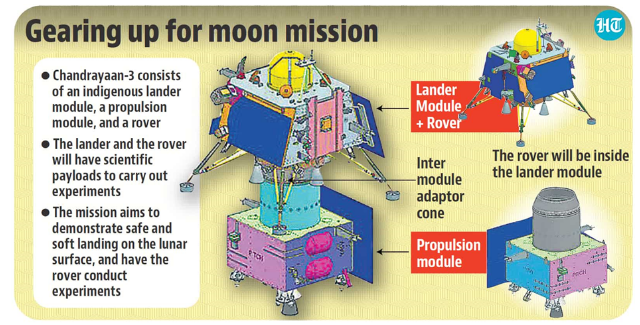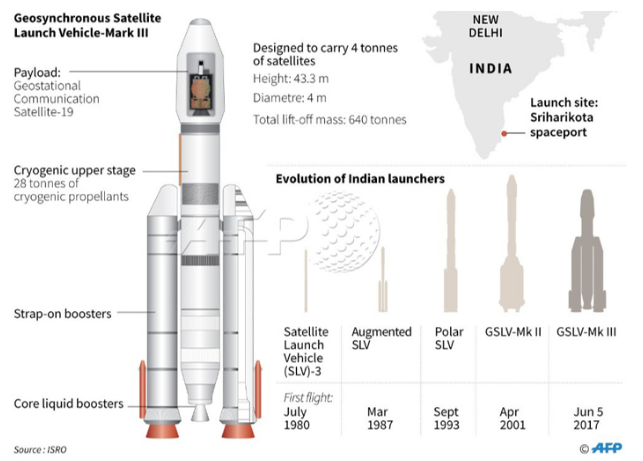Context:
On July 14, the Indian Space Research Organisation (ISRO) plans to launch the Chandrayaan-3 mission to the moon onboard a Launch Vehicle Mark 3 from Sriharikota.
- The Lunar South Pole is the southernmost point on the Moon, at 90°S.

About Chandrayaan-3 Mission:
- It will be the world’s first mission to soft-land near the lunar south pole.
- All the previous spacecraft have landed a few degrees latitude north or south of the lunar equator.
- Successor Mission: It is the successor to Chandrayaan-1 and Chandrayaan-2, which aims to demonstrate end-to-end capability in the relevant technologies.
- Indigenous Module Mission: It is primarily a landing and roving mission.
- It consists of an indigenous Lander module (LM), Propulsion module (PM) and a Rover with an objective of developing and demonstrating new technologies required for Interplanetary missions.
- The Lander: It will have the capability to soft land at a specified lunar site and deploy the rover.
- The Rover: It will carry out in-situ chemical analysis of the lunar surface during the course of its mobility.
- LVM-3 Configuration: The mission will be carried out using the LVM-3 configuration.
- The Geosynchronous Satellite Launch Vehicle Mark III (LVM-3) is used for heavier payloads and higher orbits, with the most powerful configuration known as LVM- 3.
Objectives of the Mission:
- Landing: To demonstrate safe and soft landing on Lunar Surface.
- Roving: To demonstrate Rover roving on the Moon.
- Experimenting: To conduct in-situ scientific experiments.
What are Permanently Shadowed Regions, or PSRs?
- The Moon’s axis tilts only 1.5 degrees and because of this unique geometry, sunlight never shines on the floors of a number of craters near the lunar north and south poles. These areas are known as Permanently Shadowed Regions, or PSRs.
Why hasn’t any Spacecraft ever landed near the Lunar South Pole?
- Difficult & Different Terrain: The polar regions of the Moon have very different and difficult terrain.
- Dark Region: Many parts lie in a completely dark region where sunlight never reaches, and temperatures can go below 230 degrees Celsius.
- Lack of sunlight and extremely low temperatures create difficulty in the operation of instruments.
- Presence of Large Craters: In addition, there are large craters all over the place, ranging from a few centimeters in size to those extending to several thousands of kilometers.
Why do Scientists want to explore the Lunar South Pole?
- Curiosity to Explore: Due to their rugged environment, the polar regions of the Moon have remained unexplored.
- Several Orbiter missions have provided evidence that these regions could be very interesting to explore.
- Presence of Ice Molecules & Water: There are indications of the presence of ice molecules in substantial amounts in the deep craters in this region — India’s 2008 Chandrayaan-1 mission indicated the presence of water on the lunar surface with the help of its two instruments onboard.
- Clue to Early Solar System: In addition, the extremely cold temperatures here mean that anything trapped in the region would remain frozen in time, without undergoing much change.
- The rocks and soil in Moon’s north and south poles could therefore provide clues to the early Solar System.
- Unique Craters: The lunar south pole region features craters that are unique in that the near-constant sunlight does not reach their interior.
- Such craters are cold traps that contain a fossil record of hydrogen, water ice, and other volatiles.
Learnings from Chandrayaan-2 to improve the success of Chandrayaan-3:
- Chandrayaan-3 is largely a replica of its predecessor, Chandrayaan-2, that was launched in July 2019 in the form of an orbiter and a lander bearing a rover.
- Reasons of Partial Failure of Chandrayaan-2:
- While the orbiter entered into orbit around the moon, the surface mission failed when the lander crashed instead of executing a slow descent.
- ISRO later identified a problem in the guidance software and unexpected dispersion in the propulsion system during certain phases of the descent.
- Lesson Learnt for Chandrayaan-3:
- In Chandrayaan-3, the rocket will place the payload in an elliptical orbit around the earth, where a propulsion module will take over and pilot the lander to a circular orbit around the moon.
- Finally, the lander will detach and begin a series of maneuvers culminating in a gradual landing over the surface.
- To improve the chances of success at this stage, ISRO has strengthened the lander’s legs, lowered its minimum thrust, enhanced the availability of power, and upgraded the landing sequence.
Significance of Chandrayaan-3 for India:
- Showcasing Capabilities: It showcases India’s scientific and technological capabilities.
- Scientific Exploration: It will help India gain valuable knowledge and experience in space exploration, which can be applied to other fields, such as satellite technology and space tourism.
- Human Space Exploration: Test technologies, study effects of long duration space travel & prepare for future crewed missions beyond Earth.
- Scientific & Political Milieus: It offers opportunities for India to lead the world’s response to the moon’s growing importance in the scientific and the political milieus.
- Scientific Temper: It will inspire the younger generation to pursue careers in science, technology, engineering, and mathematics (STEM) fields, thereby contributing to the country’s overall development.
Additional Informations:
Moon Missions of India:
| Mission |
Chandrayaan-1 |
Chandrayaan-2 |
Chandrayaan-3 |
| Launch Year |
2008 |
2019 |
2023 (Scheduled for July 14) |
| Consists Of |
Lunar Orbiter |
Lunar Orbiter, Lander & Rover |
Lunar Lander & Rover |
| Findings |
Detected water molecule on Moon |
Lander crash- landed on Moon |
Yet to be determined |
| Notable Features |
Helped in discovering water molecule on the Moon;s surface |
First Indian mission to attempt a soft landing on the Moon |
Designed with a failure-based approach & improved landing area |
Experiments of Chandrayaan-3:

Image Source: The Hindustan Times
| Experiment |
Description |
| Chandra’s Surface Thermophysical Experiment (ChaSTE) |
To measure thermal conductivity and temperature on the surface |
| Instrument for Lunar Seismic Activity (ILSA) |
To detect moonquakes |
| Langmuir Probe |
To estimate the density and variation of plasma, or superheated gas, in the moon’s environment |
| A Laser Retroreflector Array (from NASA) |
To measure distances using laser ranging |
| Experiment |
Description |
| Alpha Particle X-ray Spectrometer (APXS) |
To look for elements in the lunar soil and rocks |
| Laser Induced Breakdown Spectroscopy (LIBS) |
To examine the chemical and elemental composition of the lunar surface |
| Experiment |
Description |
| Spectro-polarimetry of Habitable Planet Earth (SHAPE) |
To gather data on the polarization of light reflected by Earth so that researchers can look for other planets with similar signatures |
About LVM-3:
- It is developed by the Liquid Propulsion Systems Centre of ISRO
- Payload capacity: LVM3 will be capable of placing
- 4 tonne class satellites of the GSAT series into Geosynchronous Transfer Orbits (in a nominal time of 974s).
- 8 tonne heavy payloads into Low Earth Orbits of 600 km altitude.
Stages of LVM3:
- First Stage:
- It has two S200 boosters strapped to the sides of the rocket body.
- Fuel Used: Solid fuel called hydroxyl terminated polybutadiene.
- Second Stage:
- It is powered by two Vikas engines
- Fuel Used: Liquid fuel – either nitrogen tetroxide or unsymmetrical dimethylhydrazine.
- Uppermost Final Stage:
- It is powered by a cryogenic engine.
- It is configured with the fully indigenous high thrust cryogenic engine (CE20)
- It combusts liquefied hydrogen with liquefied oxygen.
- Hydrogen has a very high specific impulse as rocket fuels go, but using it in an engine requires it to be liquefied first.
- Liquified hydrogen must be stored at very low temperature, and with special pumping and transport systems.

Image Source: AFP
The Artemis Accords:
- By NASA for Common Guidelines: Led by NASA, these are a set of statements that set out common principles, guidelines, and best practices that are applicable to the safe exploration of the moon and eventually beyond as humanity extends the duration of space missions and its reach to Mars.
- Aims for a New Era of Space Exploration: It aims to kick start a new era of space exploration and put the first woman and person of color on the moon in 2024, international partnerships with numerous countries and private companies are vital to its success.
News Source: The Hindu
![]() 12 Jul 2023
12 Jul 2023



